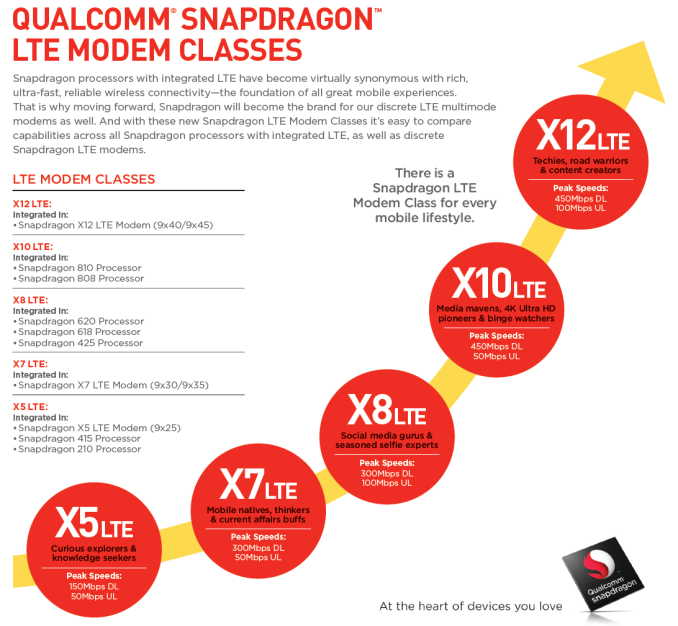Qualcomm Announces New SoC Lineup, Modem Branding
by Andrei Frumusanu on February 18, 2015 8:47 AM EST
Qualcomm today announced 4 new additions to its Snapdragon 400 and 600 lineup of SoCs, along with a reshuffle and rebranding of their modem lineup. Let's begin with the new SoC offerings:
The Snapdragon 415 and 425 are additions to the low-end of Qualcomm's SoC offerings. The Snapdragon 415 is described a "quick transition piece" to the Snapdragon 410 which we suspect means it will be a pin-compatible SoC upgrade. It doubles up on the core-count from 4 A53 processors up to 8. The cores are still clocked in at the same 1.4GHz frequency. On the GPU side we see an upgrade from the Adreno 306 to a newer Adreno 405 and memory speeds have been slightly bumped from 533MHz to 667MHz LPDDR3, dropping LPDDR2 capability from the SKU.
| Qualcomm Snapdragon 400 Lineup | |||
| SoC | Snapdragon 410 | Snapdragon 415 | Snapdragon 425 |
| CPU | 4x Cortex A53@1.4GHz | 4x Cortex A53@?GHz 4x Cortex A53@1.4GHz |
4x Cortex A53@?GHz 4x Cortex A53@1.7GHz |
| Memory Controller |
1x 32-bit @ 533MHz LPDDR2/3 4.2GB/s b/w |
1x 32-bit @ 667MHz LPDDR3 5.3GB/s b/w |
1x 32-bit @ 933MHz LPDDR3 7.5GB/s b/w |
| GPU | Adreno 306 | Adreno 405 | Adreno 405 |
| Encode/ Decode |
1080p H.264 | 1080p H.264 1080p30 HEVC decode |
1080p H.264 1080p30 HEVC decode |
| Camera/ISP | 13.5MP | 13MP | Dual ISP 21MP |
| Integrated Modem |
Cat. 4 150Mbps | "X5 LTE" Cat. 4 150Mbps DL 50Mbps UL |
"X8 LTE" Cat. 7 300Mbps DL 100Mbps UL 2x20MHz C.A. (DL & UL) |
The Snapdragon 425 is also a octa-core A53 unit with the same GPU implementation, but clocked at a slightly higher 1.7GHz on the one of the A53 clusters. It's on the integrated modem side where things change, as the S425 employs a new integrated "X8 LTE" Category 7 LTE modem versus the Category 4 one found in the S415. The new unit also brings down the dual-ISP feature from the higher-end SoCs to the entry-level, enabling dual cameras up to 21MP. This should be an interesting SoC in the entry range as the specifications in terms of performance seem to match the Snapdragon 615 of the mid-range series.
While the entry range gets some large performance and connectivity boosts, today's biggest news comes in form of the Snapdragon 618 and 620. These are the first announced Cortex A72 SoCs, ARM's new high-end CPU architecture which was publicly announced just two weeks ago.
| Qualcomm Snapdragon 600 Lineup | ||||
| SoC | Snapdragon 610 | Snapdragon 615 | Snapdragon 618 | Snapdragon 620 |
| CPU | 4x Cortex A53@1.7GHz | 4x Cortex A53 @1.0GHz 4x Cortex A53 @1.7GHz |
4x Cortex A53 @1.2GHz 2x Cortex A72 @1.8GHz |
4x Cortex A53 @1.2GHz 4x Cortex A72 @1.8GHz |
| Memory Controller |
1x 32-bit @ 800MHz LPDDR3 6.4GB/s b/w |
1x 32-bit @ 800MHz LPDDR3 6.4GB/s b/w |
2x 32-bit @ 933MHz LPDDR3 14.9GB/s b/w |
2x 32-bit @ 933MHz LPDDR3 14.9GB/s b/w |
| GPU | Adreno 405 | Adreno 405 | "Next-gen" Adreno | "Next-gen" Adreno |
| Encode/ Decode |
1080p H.264 1080p30 HEVC decode |
1080p H.264 1080p30 HEVC decode |
2160p30, 1080p120 H.264 & HEVC |
2160p30, 1080p120 H.264 & HEVC |
| Camera/ISP | 21MP | 13MP | Dual ISP 21MP |
Dual ISP 21MP |
| Integrated Modem |
Cat. 4 150Mbps DL 50Mbps UL |
"X5 LTE" Cat. 4 150Mbps DL 50Mbps UL |
"X8 LTE" Cat. 7 300Mbps DL 100Mbps UL 2x20MHz C.A. (DL & UL) |
"X8 LTE" Cat. 7 300Mbps DL 100Mbps UL 2x20MHz C.A. (DL & UL) |
The Snapdragon 618 and 620 bring dual-channel memory back into the mid-range, employing LPDDR3 targeted at 933MHz, making them on par with today's Snapdragon 800 and 801 SoCs. The new offerings now employ full HEVC (H.265) hardware encoding and decoding, a feature first seen in the Snapdragon 810. Similarly to the 425, the usually high-end dual ISP functionality is brought down into the new SKUs and offer up to 21MP camera sensor functionality.
What Qualcomm doesn't specify though, is the GPU. We're being promised a new "next-generation" Adreno GPU, so we might be talking about a new 500-series, but we don't know for sure until Qualcomm actually announces the new architecture.
The Snapdragon 618 and 620 employ Qualcomm's new "X8" integrated modem solutions, capable of Category 7 LTE with up to 300Mbps downstream or 100Mbps upstream via 2x20MHz carrier aggregation on either upload or download channels.
Getting back to the CPU configuration: The Cortex A72 replaces the use of a higher-clocked A53 cluster as the "big" part of these new big.LITTLE SoCs. The A72 was announced as ARM's new flagship high-end core, so it's very interesting to see Qualcomm employ it in a mid-range SoC at only 1.8GHz. It would look like these new units are still manufactured under 28nm given the clock speeds. We still don't know much about the A72 core, but ARM's Peter Greenhalgh clarified that we should be seeing a 10-50% IPC gain over the A57 while improving power on the same process node and libraries. To see Qualcomm use the A72 in a mid-range SoC begs the question of exactly how big these new cores are, as pricing is be an important competitive factor below the high-end.
Qualcomm expects the Snapdragon 415, 425, 618 and 620 to ship in consumer devices in the latter half of 2015. This is an interesting timeline as the 618 and 620 pose direct competition to the Snapdragon 808 which we still haven't seen announced in any consumer device. On the high-end, Qualcomm is still keeping very quiet as we still don't know what the successor to the Snapdragon 810 will look like or what the state of Qualcomm's new ARMv8 core is in.
Modem re-branding
Finally as part of today's announcement, is a re-branding of Qualcomm's modem line-up. The "Gobi" name is abandoned in favour of a "X# LTE" denomination. It's to be noted that the model numbers don't correspond to actual LTE category capability, as for example the X10 and X12 modems are capable of respectively Category 9 and 10 LTE. The aforementioned parts are re-brandings of the modem variants which we find in the standalone Gobi 9x45 and 9x40 and Snapdragon 808 and 810 SoCs.
Today Qualcomm raised the bar for low- and mid-range SoCs and we're looking forward to what kind devices Qualcomm's OEM partners will come up with towards the end of the year.











40 Comments
View All Comments
Andrei Frumusanu - Wednesday, February 18, 2015 - link
It can't do carrier aggregation on the upload channels.Einy0 - Wednesday, February 18, 2015 - link
It still blows my mind how much performance these mobile cores can pump out with only a single 32bit memory channel or dual 32bit on the high end. 14.9GB/s shared between 8 processors and a GPU. I keep wondering how much more performance you could get if you doubled the memory channels or the width of the channels( ie. 4x32bit or 2x64bit). Are these architectures so memory bandwidth efficient they don't need more or is it the huge bottleneck it appears to be? If they don't need more bandwidth could the same principles be scaled to high end GPUs and CPUs without loosing too much efficiency? I know comparing desktop processors and GPUs to mobile parts is like comparing apples to oranges but it still makes me wonder...BillBear - Wednesday, February 18, 2015 - link
Now that you guys have someone who is able to selectively disable cores on a SOC, I would dearly love to see common tasks benchmarked with varying numbers of cores enabled.It would be great to see how mature Android and common apps running under Android are when it comes to taking advantage of multiple cores.
victorson - Thursday, February 19, 2015 - link
This.phoenix_rizzen - Thursday, February 19, 2015 - link
If someone had access to a rooted Android device running a custom kernel with a bunch of CPU governors, CPU hotplugs, and I/O schedulers available, it would be really interesting to get a deep-dive on how they affect performance across various numbers of CPUs in a big.LITTLE setup. :)Granted, it would probably take a week+ to really get the numbers correctly, but it would definitely be interesting to read.
If anandtech.com wants to ship me the hardware and software, I'd be interested in writing it up. ;)
sseemaku - Thursday, February 19, 2015 - link
I feel Qualcom can do better in naming their products. Its too confusing!phoenix_rizzen - Thursday, February 19, 2015 - link
Yeah, it would have been nice if they incremented things by 100 for the 64-bit SoCs.Snapdragon 400, 600, 800 for the 32-bit ARMv7 SoCs.
Snapdragon 500, 700, 900 for the 64-bit ARMv8 SoCs.
And then they could have switched up to the 1000s for their custom ARMv8 SoCs.
But, that would be too logical for Qualcomm. :)
Valis - Thursday, February 19, 2015 - link
When are the Snapdragon 808 based mobiles coming? I haven't seen a single one being announced, yet.Azurael - Saturday, February 21, 2015 - link
Why so many cores? Big.Little doesn't seem to be working out to well from a power or performance point of view. I've been running Android on an i3 4020y (1.5GHz dual core, HT but no turbo) tablet lately and it beats the pants off of any ARM device I've used in the same environment. I think Apple have the right idea with regard to ARM SoCs...Azurael - Saturday, February 21, 2015 - link
too well*